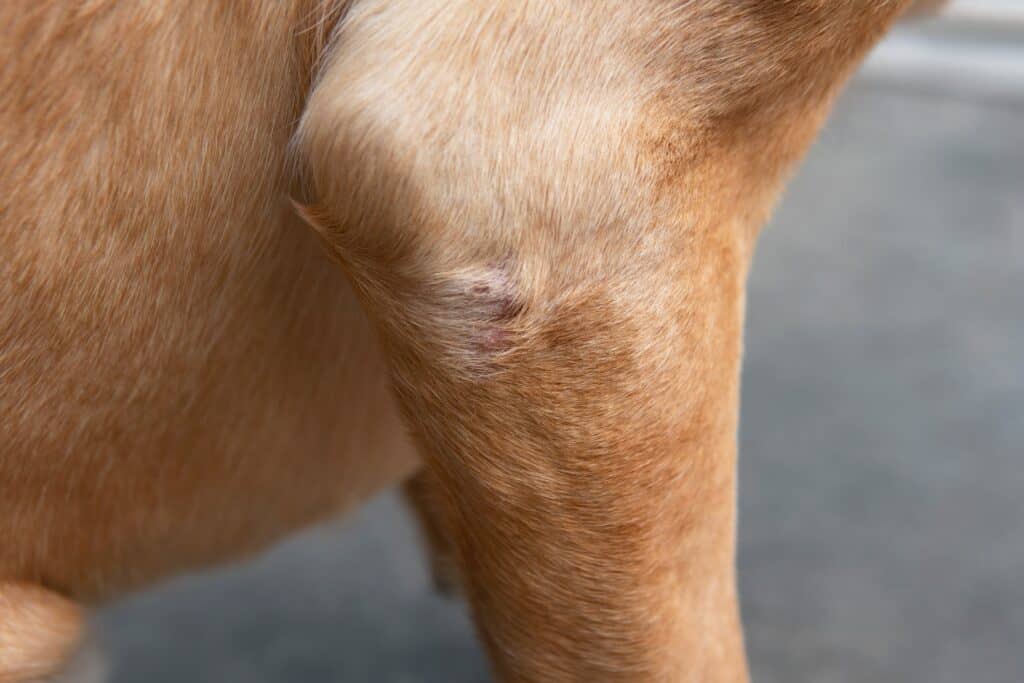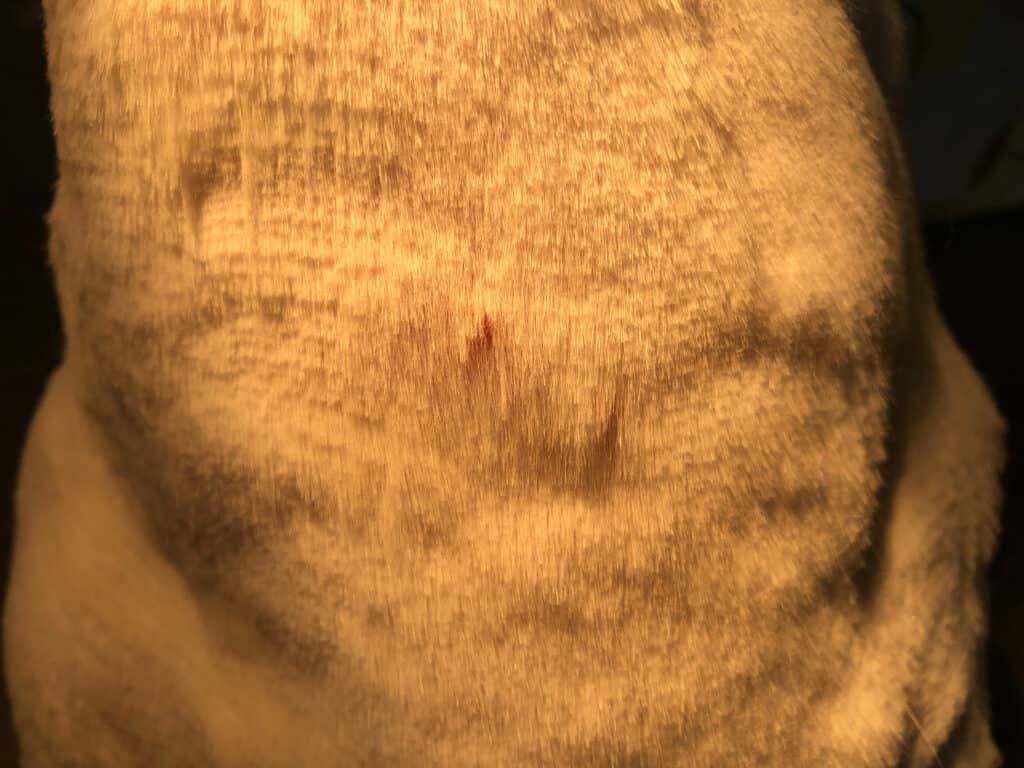Itching can drive pet owners nuts, especially if the dog is sitting next to you rapidly using their hind leg to scratch. Some causes of itching aren’t usually a cause for concern, but sometimes there can be.
The first step to easing their discomfort and your stress is to find the cause of the issue. After you find the reason, you can fix it! Your vet can help you with treatment plans based on the cause. Sometimes the itching is caused by dry skin, parasites, or certain allergies.
You’ll learn about how dogs show symptoms and when to worry about it. This article will cover most of the reasons a dog is scratching like crazy and what can be done about it. So stop scratching your head and start reading this post!
1. Dry Skin
Itching in doggies can be caused by several different things, but one of the most common causes is simply dry skin. This can be caused by the weather getting colder and the air getting drier. It can strip away the natural oils that keep your pup’s skin healthy and hydrated. This can lead to itchiness, redness, and even flaking skin.
The good news is a few simple things can help relieve your dog’s dry skin. Adding a fish oil supplement to their diet will help to replenish their natural oils, and bathing them less often with a gentler shampoo will also help to reduce irritation. You can help your four-legged friend feel comfortable and itch-free all winter with extra care.

Dry skin can be one reason for your dog’s scratching.
©9gifts/Shutterstock.com
2. FAD
Within minutes of contact, fleas feed on the blood of your dog. A flea leaves its saliva in your dog’s skin when it feeds. Enzymes, amino acids, and peptides are present in this saliva. Additionally, it has substances resembling histamine and causes the dog’s immune system to release chemicals. In susceptible species, flea saliva can trigger an inflammatory response.
Some dogs react to it immediately and become hypersensitive within minutes. Others respond slowly and become hypersensitive within two days. Atopic dermatitis in dogs increases their risk of flea allergic dermatitis (FAD). While you might not immediately notice fleas, you will see signs of an allergic reaction. This allergic reaction can be brought on by just one flea bite. Dogs frequently gnaw and bite at their backs by their tails or get up from a laying position when they detect flea bites.
Consider flea allergy dermatitis if your dog exhibits irritation that results in hair loss around the center of the back to the base of the tail. If left untreated, hair loss may progress to the head as well as other parts of the body. The skin barrier is broken when a dog scratches or chews, which may result in open sores or scabs. The chewing can also produce persistent wetness, resulting in bacterial and yeast infections.

A flea that leaves saliva within a dog’s skin could cause FAD, leading to very itchy lesions.
©MeowDr/Shutterstock.com
3. Seasonal Allergies
When dogs come into contact with or breathe anything they are sensitive to, they develop seasonal allergies. More specifically, allergies occur when their immune system loses its tolerance for an allergen. Whenever the immune system comes into contact with an allergen in the environment, it goes berserk and unleashes an inflammatory response.
This results in all or part of the symptoms mentioned later in this section. Factors that are only present at certain times of the year, such as tree pollen, dust mites, and fresh grass in the summer, are some of what cause seasonal allergies. Dogs react to allergies in a slightly different way than people do.
Some symptoms of seasonal allergies in dogs are itchy skin and repeated ear infections, but your dog may also exhibit red eyes, a runny nose, and fits of sneezing. Your pet may become itchy at any level, from severe to minor. Dogs are prone to self-mutilation. So it’s worth taking them to the vet if you discover that they are scratching or gnawing on themselves more often than usual. This habit can result in infections that are uncomfortable and necessitate treatment. Look out for symptoms, including odd discharge and odor.
4. Food Allergies
An immune system reaction to a trigger causes allergies. And no matter what you appear to do to cure the symptoms, the issues and discomfort will persist if your dog is exposed to the allergen regularly. Dogs rarely experience true food allergies. Dog food allergies account for about 10% of all allergy cases. In contrast to food allergies, dogs can also have a food intolerance.
Dog food allergies can be diagnosed and treated very easily. Dogs shouldn’t ever consume their allergens. For dogs with multiple, severe food allergies, this may be best done by keeping them on the prescription dog food for dogs with allergies that they were given during their trial. Grain-free dog foods, limited ingredient diets, or appropriate over-the-counter dog foods may effectively treat milder cases.
But keep in mind that flare-ups could occur if these diets are mixed with components not stated on the label. Consult your vet to find out which foods are ideal for your dog’s diet. Even while food allergies can’t be cured, they can be effectively managed with the right dog food for allergic dogs.
5. Contact Dermatitis
Numerous factors can contribute to contact dermatitis. It can be regarded as a standalone illness or a sign of other diseases. Your dog may exhibit symptoms immediately or over a few days if they come into contact with something irritating their skin. Treatment usually takes symptomatic therapy to alleviate your dog’s symptoms before they get worse. An antihistamine may be prescribed to stop your dog from scratching and causing infections. When diagnosed with contact dermatitis, most dogs bounce back quickly without any long-term consequences.
A material that damages the skin or an immune system response can cause your dog to develop contact dermatitis, a skin ailment. Take your dog to a vet if you see that he has acquired skin irritation, is scratching a lot, and appears to be suffering from itching. Dogs most frequently get one of two types of contact dermatitis: allergic or irritant contact dermatitis. When the skin is sensitive to a specific, actually-harmless chemical, allergic contact dermatitis develops.
The body’s immune system responds when exposed to the drug because it believes it needs to defend itself. For instance, if your dog is sensitive to the soap you put on them, they will develop dermatitis symptoms each time you bathe them. Irritant contact dermatitis occurs if the skin comes into contact with anything that causes immediate skin injury. Skin damage can develop after a single encounter with the drug or after several. For instance, certain plants exude a chemical that, if your dog brushes up against it, can irritate their skin and result in contact dermatitis.
6. Sarcoptic Mange (mites)
An infectious skin condition known as sarcoptic mange that affects the hair follicles can be spread from animals to people. Sarcoptic mange is a condition that can be severely crippling and occasionally even fatal. Sarcoptes scabiei is the culprit behind scabies and sarcoptic mange. Both humans and other animals are susceptible to this parasitic mite’s easy transmission.
These mites, primarily found on foxes, play a significant role in domestic dog infestation. These mites trigger an allergic reaction in dogs; therefore, only a few are required to produce significant clinical symptoms. Scabies typically affects malnourished dogs or neglected or have weakened immune systems. Less frequently does it occur in healthy dogs living in loving households.
Papules are raised pimples that commonly appear on the body or the chest. The skin lesions, which might arise as crusted lesions, are frequently the origin of secondary skin infections. In cases of sudden, intense itching in dogs, especially younger dogs, scabies should always be assessed and treated to stop the symptoms from worsening.

Mange is an infectious skin condition that can cause itching and scratching in dogs.
©MDV Edwards/Shutterstock.com
Conclusion
Some causes of your dog’s crazy itching can be explained by dry skin if no other symptoms are present. If you notice swollen skin, redness, or signs of infection from the area scratched, then take them to a vet. You can take them to the vet if you’re worried about their scratching habits just to double-check that there isn’t a reason for concern.
If food allergies or something more severe like Sarcoptic Mange is present, then your vet can work with you and solve the problem much quicker than you trying to solve the issue on your own. Your dog is so lucky that you’re a great dog owner! Check out our other helpful animal articles linked below and share this if you know someone whose dog always itches!
Up Next:
- Dogs and Benadryl: Is it safe, and how much can you give?
- The Best Fish Oil for Dogs: Reviewed and Ranked for 2022
- If Your Dog Has Fleas, This Is How to Remove Them for Good
The photo featured at the top of this post is © kobkik/Shutterstock.com
Ready to discover the top 10 cutest dog breeds in the entire world?
How about the fastest dogs, the largest dogs and those that are -- quite frankly -- just the kindest dogs on the planet? Each day, AZ Animals sends out lists just like this to our thousands of email subscribers. And the best part? It's FREE. Join today by entering your email below.
Sources
- , Available here: https://www.merckvetmanual.com/dog-owners/skin-disorders-of-dogs/itching-pruritus-in-dogs
- , Available here: https://www.applevalleyanimalhospital.com/site/blog/2021/09/30/why-is-my-dog-scratching-and-itching
- , Available here: https://www.petmd.com/dog/symptoms/why-my-dog-itching-so-much
- , Available here: https://www.dailypaws.com/dogs-puppies/health-care/dog-conditions/why-is-my-dog-so-itchy
Thank you for reading! Have some feedback for us? Contact the AZ Animals editorial team.






